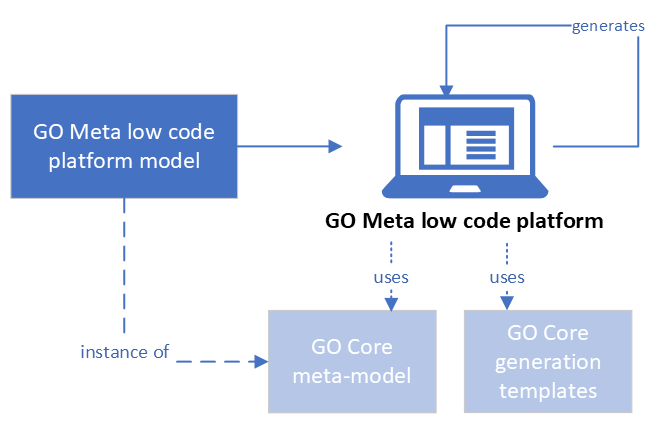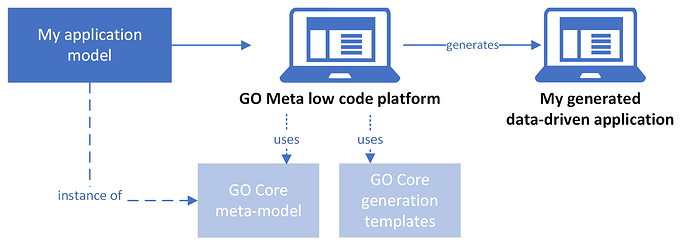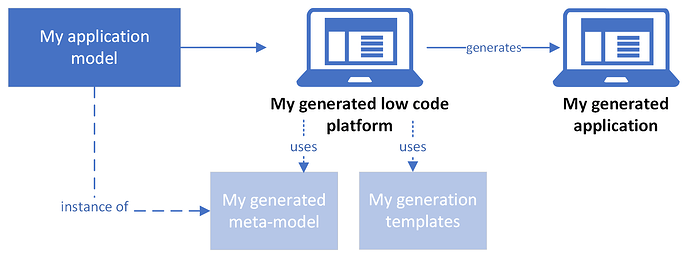Hello everyone !
I present in this post, the new “meta low code” approach I am proposing, and implemented in the coming version of the Generative Objects platform.
I just copy here an article that is about to be published in CIO Application
I am looking forward for your feedback, suggestions, questions !
Generative Objects (GO), introducing the Meta Low Code approach
The low code approach is the new trend in developing software, bringing the promise of more agile and faster development of software while empowering non-technical users and bridging the gap between end users and technology.
However, the first generation of low code platforms that exists today comes with a double edge limitation, barrier to adoption:
- The applications that can be built are limited to the kind of applications a given low code platform was designed for, mainly data driven web applications.
- The applications are limited to follow the built-in architecture and design. You have little or no control over the technological stack and architecture.
This can be very restrictive for users who have specific functional needs that go beyond simple data management applications. On the technical side, the IT department usually does not like to have no control over the target technological stack, especially if the low code platform is relying on a black-box runtime.
Generative Objects (GO) goes much beyond, pioneering a new generation of low code platforms. With the introduction of our “Meta low code” approach, the versality and power of the original low code approach is rocketed to a whole new level.
The GO platform functions though a code generation paradigm, and a GO instance is composed of :
- A Functional meta-model. The meta-model is the non-tech, functional language used by business users to define and describe target applications. This model is de-coupled from the technological target stack. The core GO meta-model is for modeling data-driven applications.
- A pipeline of generation templates, and other tasks, used to transform the meta-model instance to a working application, on a given technical architecture. The core GO pipeline is targeting a centralized architecture, on top of .NET technologies.
The “meta” part of “meta low code” means that the low code platform is self-reflective: it is abstracted as a meta-model and a set of code generation templates and is, itself, a generated application. The GO platform is literally modelled and generated by itself :
The GO platform can therefore be used to extend or adapt the GO platform itself, or even to create fully specific low code platforms, empowering users with full control both at a functional and a technical level.
GO can be used out of the box as a ready-to-use low code platform to create data-driven applications, as a classical low code platform :
But to go further, the IT department can use GO to craft the exact low code platform that suits their organization’s functional and technical needs :
The business users can then use this new, specific low code platform to build their applications:
If the objective is to merely create data-driven applications, the IT department can keep the core GO functional meta-model, and optionally adapt or rewrite the generation templates to fit their technical requirements and target architecture.
In case of specific functional needs, the IT department can also literally craft a full-fledged specific low code platform by creating with GO a full, new application meta-model and associated generation templates pipeline.
As an example of a specific meta-model, we could use GO to create a low code platform for designing and deploying surveys with a functional language specific to surveys.
As an example of a specific generation templates pipeline, we could use GO to create a pipeline targeting a decentralized architecture, on top of decentralized technologies like Holochain (http://holochain.org) or others.
The GO platform is about to be fully open sourced (public opening before end 2021), with the intention to democratize access to meta low code technology and ensure wide adoption. We will lead a community of developers in growing the GO platform itself and the code generation pipelines, and of business users in growing a catalog of functional meta-models.
Alongside the open sourcing of GO, we will propose a cloud offering, to get immediate working access to GO platform private instances.
Generative Objects has been used in production over the last 12 years, on many enterprise applications for corporate companies, mainly in France.




